Thinking about adding some life to your home? Growing indoor plants is a fantastic and fulfilling hobby. Whether you’re an experienced gardener or a beginner, many plants flourish indoors. From tiny succulents to vibrant ferns, this guide offers insights into indoor gardening. Learn how to help your plants thrive beautifully in your home.
Humidity Levels and Indoor Plant Health

Maintaining proper humidity is key for healthy indoor plants. This image features a hygrometer next to several potted plants. The hygrometer accurately measures air moisture, helping you determine if your home’s environment is ideal for your plants’ well-being.
Plant humidity needs vary significantly. Tropical varieties, such as ferns and peace lilies, thrive in high humidity. Succulents, conversely, prefer drier conditions. A hygrometer is essential for monitoring humidity levels. Adjust your plant care based on these readings. Consistent monitoring prevents problems like leaf browning and wilting.
Increase humidity for your plants by misting them regularly. A humidifier is another excellent option. Alternatively, place a water tray nearby. Grouping plants fosters a naturally humid environment. Aim for a balanced humidity level to ensure thriving, healthy plants.
Essential Light Requirements for Indoor Plants
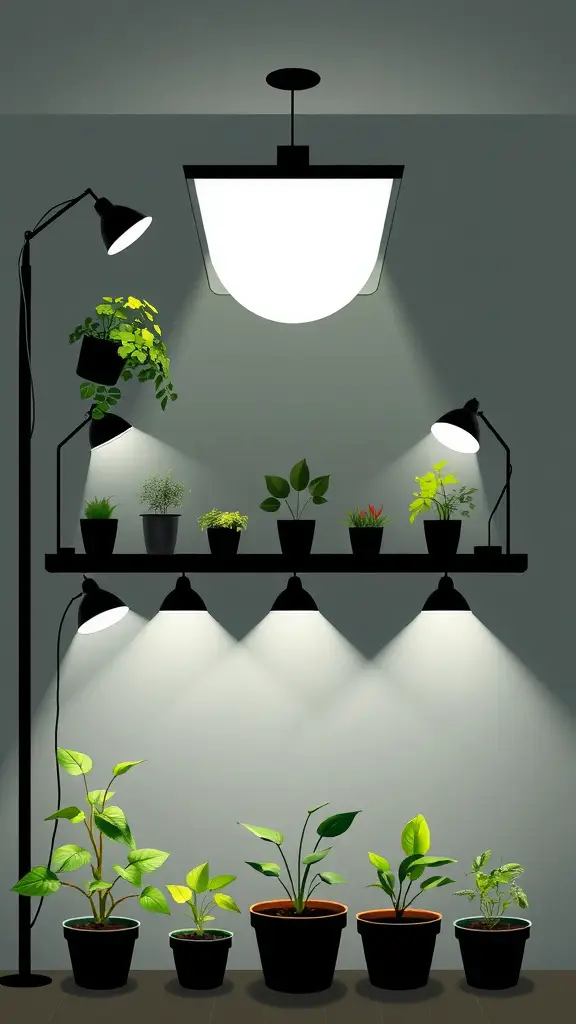
Indoor plant growth hinges significantly on light. This image highlights a thriving indoor garden. Notice how various light sources combine to form a perfect plant-growing atmosphere.
The arrangement boasts diverse lighting solutions. A central overhead fixture and adjustable spotlights ensure abundant light. This bright environment is ideal for plants needing strong light to flourish. Every plant on the shelves appears vibrant, indicating optimal light exposure for healthy growth.
Plant light requirements vary significantly. Some thrive in direct sunlight, while others flourish in dimmer environments. This setup accommodates diverse plant needs, simplifying optimal care. Adjustable lights offer precise control over intensity and direction, crucial for healthy plant development in 2025.
Remember, light exposure duration is key. Most indoor plants thrive with 12-16 hours of daily light. Use a timer to guarantee consistent light, even when it’s cloudy outside. This ensures optimal growth.
Fertilizing Indoor Plants for Optimal Growth
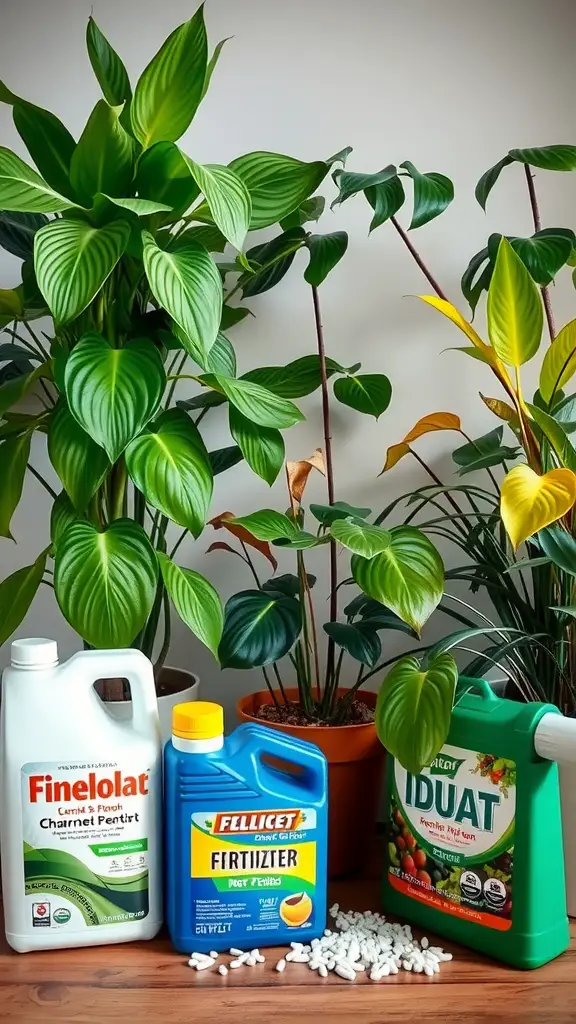
Bring your indoor spaces to life with vibrant, colorful plants! Proper fertilization is essential for maintaining their health and beauty. This image displays a selection of fertilizers alongside thriving green plants. It highlights the essential tools for your plant care regimen, ensuring your plants flourish.
This image showcases three distinct fertilizer types. Each boasts a specialized formula, crafted to nourish your plants in unique ways. Notice the variations in color and packaging, yet all aim to boost the vitality of your indoor plants. Always carefully read the labels to select the ideal fertilizer for your plant’s specific needs.
Tailor your fertilization strategy to each plant’s specific needs. Some thrive with extra nitrogen, while others prefer more phosphorus or potassium. Consistent feeding throughout the growing season significantly boosts growth and enhances their visual appeal.
For optimal fertilizer use, always read the package directions carefully. Usually, you’ll dilute the fertilizer in water. Apply this mixture when you normally water your plants. Avoid over-fertilizing, which can damage them.
Using organic choices, such as compost, is highly recommended. Compost slowly releases vital nutrients and boosts soil quality. Healthier plants are naturally stronger. This resilience ensures your indoor garden thrives for many years.
Watering Techniques for Indoor Plants
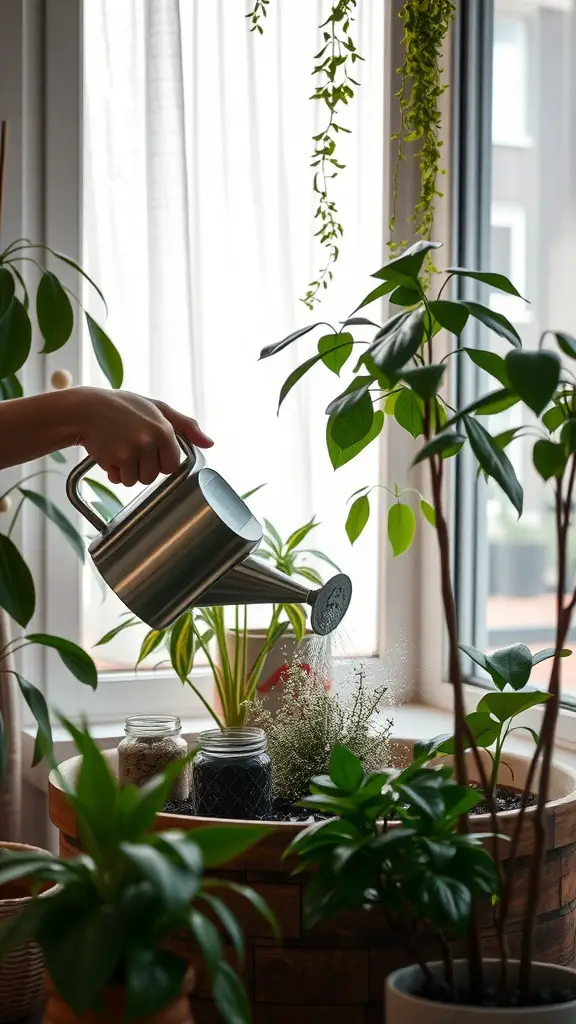
Here, a hand gently waters vibrant indoor plants with a modern watering can. Sunlight streams through the window, illuminating the lush green leaves. This scene perfectly embodies the care and attention required for successful indoor gardening in 2025.
Proper watering is essential for thriving plants. Don’t just pour water; learn each plant’s specific needs. Overwatering is as damaging as underwatering. Check the top inch of soil before watering. If it feels dry, then water.
Watering cans, such as the one shown, offer superior control. Position the spout near the soil to reduce splashing and ensure root hydration. Letting water stand before use allows chlorine to evaporate, benefiting delicate plants. This is especially important in 2025 as water quality concerns increase.
Plant watering varies greatly. Succulents and cacti need less water. Tropical plants flourish with more moisture. Use soil or pebble jars as visual reminders. This helps you remember each plant’s specific needs in your indoor garden.
Finally, check your plants frequently. Their leaves often signal when they need more or less water. Happy gardening!
Choosing the Right Indoor Plants for Your Space

Choosing the perfect indoor plants can completely revitalize your living area. Observe this image showcasing vibrant indoor foliage. Notice the diverse plant selection, each adding vitality and comfort to the room. From towering, verdant palms to smaller, vibrant species, there’s an ideal plant for every location.
Start by assessing the natural light in your space. Tall palms flourish in sunny rooms, ideal for bright areas. For dimmer spaces, snake plants or pothos are excellent choices. They are known for their adaptability to low light.
Consider your available space. For bigger rooms, use tall plants as eye-catching centerpieces. Smaller rooms are better suited for small potted plants. These fit nicely on shelves or tables without making the space feel cramped.
Elevate your plant game by combining diverse plant species. This strategy enhances visual appeal and fosters a harmonious environment. Consider pairing a towering plant with several smaller companions for a captivating and balanced arrangement.
Elevate your indoor garden with stylish pots! Select vibrant or textured options to inject personality. These choices should also beautifully complement your home’s interior design.
Soil Selection for Potted Plants
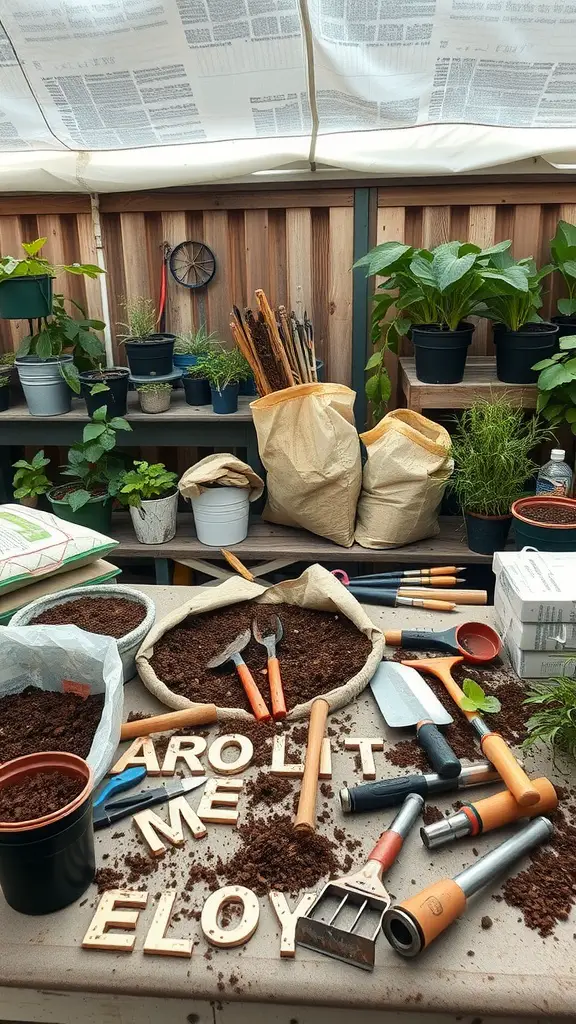
Selecting the ideal soil is crucial for thriving indoor plants. This image showcases a well-equipped workspace with diverse tools and soil types, emphasizing the importance of preparation. The assortment of pots suggests that each plant has unique soil requirements.
Choose soil based on your plants’ needs. Some need fast-draining soil. Others flourish in soil that holds moisture. The soil pictured looks loose and crumbly. This is excellent for good drainage.
Remember plant nutrition! Choose a potting mix with organic matter or fertilizer. This provides essential vitamins for healthy plant growth. Pre-mixed soil bags are often available, simplifying the process for new gardeners.
Furthermore, the available tools indicate that re-potting is an enjoyable activity. Spending time on quality soil preparation ensures healthy and vibrant plants!
Understanding the Benefits of Indoor Gardening

Growing plants indoors is now a favorite pastime for many. It’s a comforting way to stay connected to nature, right within your home. Observe the picture showcasing a vibrant indoor garden bursting with healthy plants. Every pot brings vitality and vibrancy to the area, creating a welcoming and comfortable atmosphere.
Indoor plants significantly boost air quality. They naturally remove harmful pollutants and increase oxygen levels. This creates a healthier and more refreshing home atmosphere. Picture yourself relaxing in a personal indoor garden, breathing clean, revitalized air. It’s a small change that greatly improves your everyday well-being.
Growing plants indoors offers a real sense of achievement. Seeing your plants grow strong boosts your self-esteem. Nurturing life and watching it thrive is truly rewarding. Also, indoor greenery can lower stress and create a peaceful environment.
Growing your own herbs and vegetables offers another great advantage. Imagine having fresh ingredients readily available for all your culinary creations. From adding freshly cut basil to your favorite pasta to harvesting peppers for a vibrant salad, using homegrown produce is incredibly rewarding.
Finally, indoor gardening offers a delightful shared experience for families and friends. It strengthens bonds through collaborative planting and the exchange of valuable gardening insights. Ultimately, welcoming plants into your living space cultivates happiness, well-being, and meaningful connections.
Repotting Plants: When and How
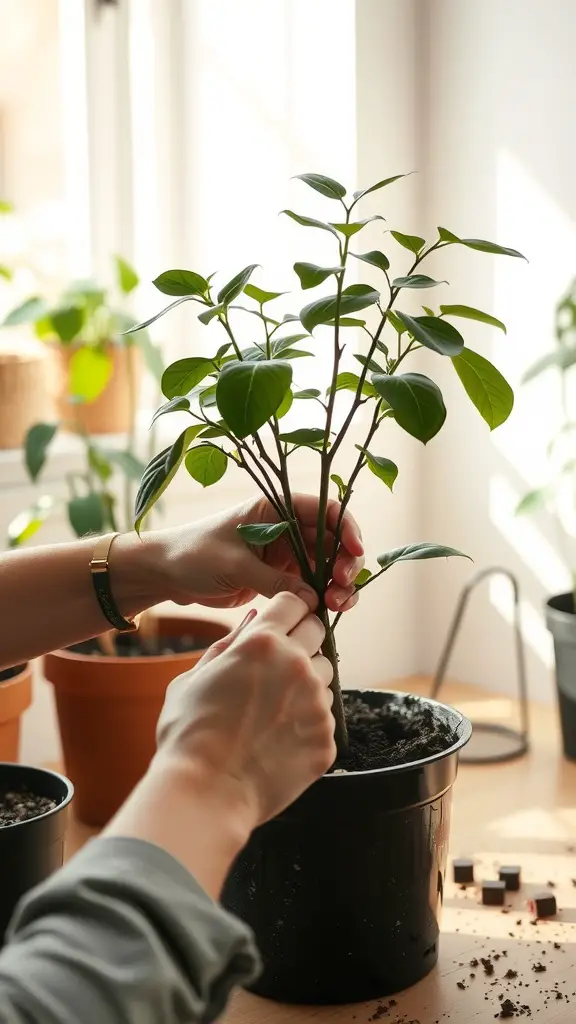
Transplanting your houseplants is key to their continued health and growth. The photo shows someone gently caring for a small plant, ready for its new pot. Sunlight floods in, illuminating the bright leaves and emphasizing the charm of indoor plants.
Understanding the right time for repotting is key. Repot when roots emerge from drainage holes. Also, repot if the plant appears too large for its current container. Annually inspect your plants during their active growing period.
Ready to repot? Get these items ready: a bigger pot, new potting mix, and your plant. Carefully take the plant out of its old pot. If the roots are tangled, gently loosen them. Put the plant in the new pot. Add soil, keeping the plant at the same depth. Water well to help the soil settle.
Repotting revitalizes your plants and you! It gives roots room to grow, promoting new, healthy development. Fresh soil provides essential nutrients, helping your indoor plants thrive. Give your plants the space and care they deserve for optimal growth!
Designing a Functional Indoor Garden Space

Crafting a welcoming indoor garden in 2025 means blending beauty with practicality. The picture showcases a sunlit, spacious area brimming with diverse plants. Expansive windows flood the room with natural light, crucial for robust plant development. The setting appears inviting, featuring comfortable seating and a minimalist coffee table, ideal for unwinding or connecting with others.
Crafting your 2025 indoor oasis? Blend hanging and potted plants for visual appeal. Notice how the greenery in the image elevates the space and creates dimension. Select plants suited to your room’s light to ensure robust growth and vibrant color.
Consider the layout carefully! The image showcases a furniture and plant arrangement that ensures easy movement. Play with varying plant heights and textures to add visual appeal. Include comfortable seating to fully enjoy your green space, perfect for reading or relaxing with a drink.
Using Grow Lights for Indoor Gardening
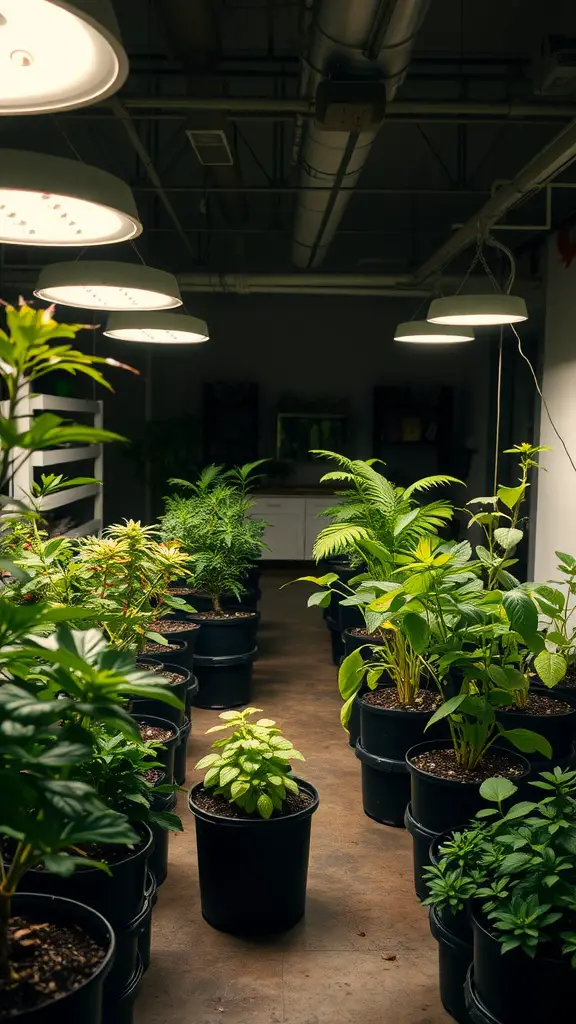
This image showcases a vibrant indoor garden. A diverse collection of plants thrives under powerful grow lights. These lights ensure optimal growth, supplying the necessary energy for photosynthesis.
Grow lights are available in various forms: LEDs, fluorescents, and HID. Each type caters to specific needs. Selecting the ideal light hinges on your plants. Leafy greens usually flourish under cooler light. Flowering plants often need warmer light tones.
Creating your indoor garden is simple. Begin by positioning your plant pots to ensure they all get equal light exposure. Place grow lights approximately 12 to 24 inches above your plants. This provides sufficient light without overheating them.
Timing is crucial! Most plants thrive with 12 to 16 hours of daily light. A timer ensures a consistent light schedule. This promotes strong and healthy plant growth. Consider using smart timers for automated adjustments based on sunrise and sunset times in 2025.
Indoor gardening is incredibly rewarding. With the correct setup, create a vibrant green oasis inside your home. Get your grow lights ready and begin your indoor garden journey!
Temperature Control for Indoor Plants
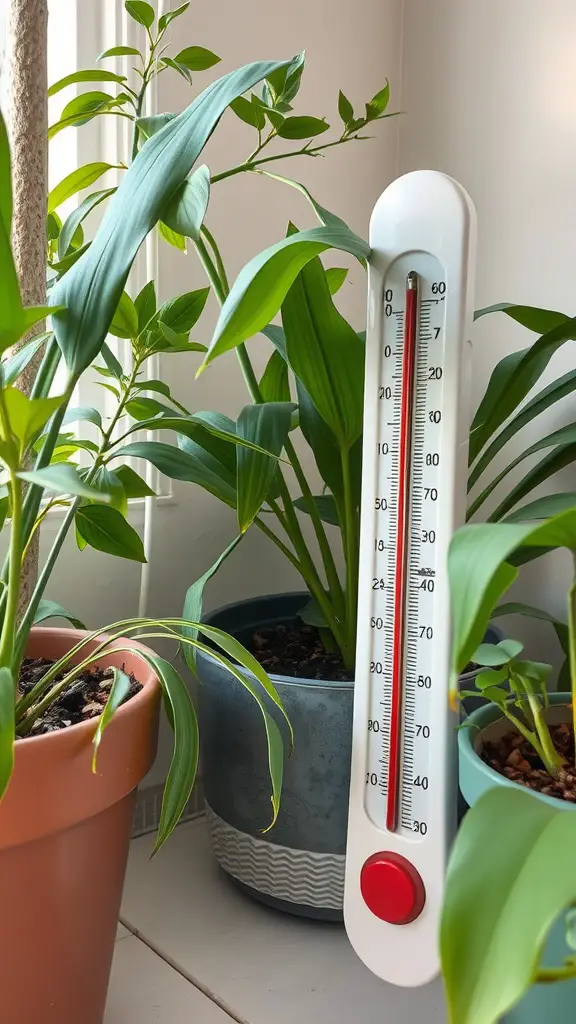
Maintaining optimal temperature is key for successful indoor plant cultivation. The picture features a thermometer nestled within vibrant green foliage. This illustrates the significance of carefully observing the environmental conditions essential for healthy plant growth.
Indoor plants thrive in temperatures between 65°F and 75°F (18°C to 24°C). Use a thermometer, similar to the one shown, to monitor the temperature. Maintaining this ideal range is crucial for healthy plant growth. Extreme temperatures can hinder their development.
Beyond using a thermometer, plant location matters. Window areas offer ample sunlight but can get cold overnight. Finding the right balance between light and temperature is key. This ensures your plants thrive without any stress.
Consistent temperature monitoring allows for proactive adjustments to your heating and cooling. If your thermostat seems inaccurate, minor adjustments, such as relocating plants or modifying vent positions, can significantly improve performance.
Propagation Techniques for Indoor Plants
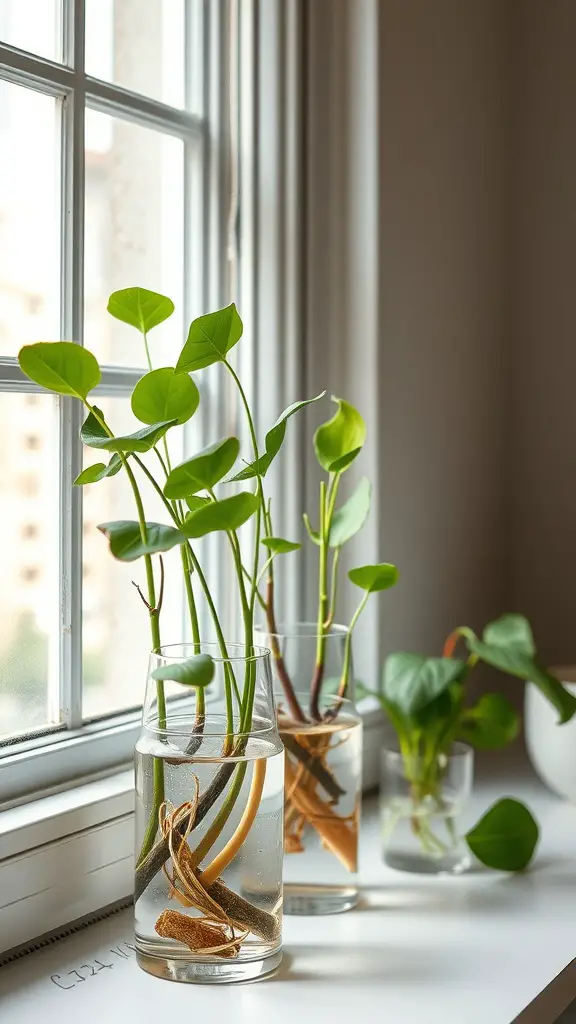
Plant propagation offers an exciting and budget-friendly method to grow your indoor garden. The image showcases cuttings in water, a straightforward and successful technique for cultivating new plants. This method remains popular in 2025.
Water propagation is a simple method. Place plant cuttings in a clear water-filled container. Witness root development firsthand – it’s rewarding! These cuttings boast vibrant green leaves, signaling their readiness for propagation.
Begin by selecting a vibrant, healthy plant. Take a cutting approximately 4 to 6 inches in length. Ensure your cut is made just beneath a leaf node; this is crucial for root development. Place the cutting in water, being careful to keep leaves above the waterline to avoid rotting.
Refresh the water every few days. This keeps it clean and boosts root development. Expect roots to appear within weeks. Once they reach a few inches, transplant your new plant into soil.
This plant propagation method is cost-effective for expanding your indoor garden. It’s also a fulfilling way to engage with the natural world within your home.
Seasonal Care Tips for Indoor Plants
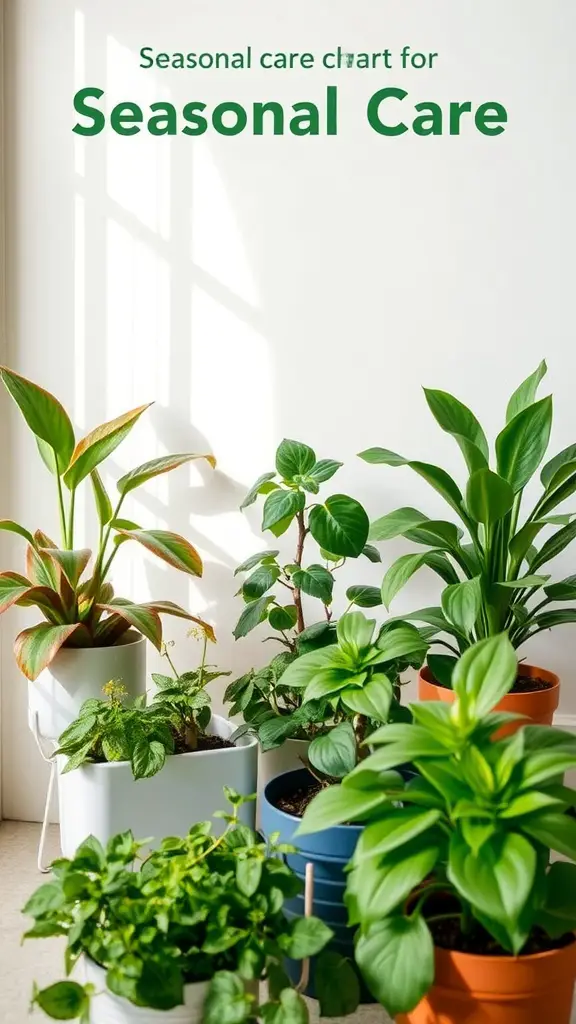
Nurturing indoor plants involves adapting to their changing seasonal requirements. This image showcases a welcoming indoor space brimming with vibrant greenery, flourishing in gentle light. It highlights the importance of providing tailored care for our plants year-round.
Spring 2025 is ideal for repotting your plants with fresh soil. This season encourages new growth, so water them more often. In summer 2025, ensure they get enough sunlight. Also, monitor humidity. Misting can help some plants on hot days.
With autumn just around the corner, gradually decrease watering. Plants are now entering a period of slower growth. It’s also a great opportunity to inspect for pests that may have infested your plants. Winter presents unique challenges, as indoor heating can create dry air. To combat this, think about using a humidifier or placing a water tray close to your plants to maintain adequate humidity.
In 2025, understanding seasonal shifts is key to keeping your indoor plants thriving. Use this updated seasonal care guide for a year-round approach to plant health.
Herbs You Can Grow Indoors
Cultivating herbs inside your home is a fantastic method to elevate both your living space and culinary creations. The picture showcases a welcoming kitchen scene featuring thriving herbs nestled in terracotta pots and a stylish metal container. Each plant introduces a vibrant touch of greenery, instantly revitalizing the atmosphere.
Basil, a common and beloved herb, is showcased in the gleaming metal pot. It’s simple to cultivate indoors, flourishing on a bright windowsill. Remember to maintain consistently moist soil, avoiding overwatering. This ensures a steady supply of fresh leaves for your culinary creations.
Other containers showcase fragrant herbs such as rosemary and mint. Rosemary thrives in sunny spots and can become quite large, infusing your kitchen with its delightful scent. Mint, known for its rapid growth, is ideal for flavoring teas and cocktails. Be sure to keep mint contained in a separate pot to prevent it from overtaking other plants.
Growing herbs indoors enhances your cooking and purifies the air. Enjoy fresh flavors all year long with an indoor herb garden. Why not start today? You might discover the pleasure of harvesting your own fresh herbs.
Common Pests and Diseases in Indoor Plants

Houseplants enhance our living spaces, yet they can sometimes invite unwelcome visitors. The picture highlights common plant pests on a leaf, enlarged for clear identification. These tiny organisms can create significant issues if not addressed promptly.
Spider mites are a frequent garden nuisance. These minuscule pests are easily missed until major damage occurs. Look for telltale yellow spots on leaves; this signals a need for careful plant inspection.
Aphids are common garden pests. They gather under leaves and drain plant fluids. This can slow down growth. Quick action is key to stopping large infestations.
Beyond pests, indoor plants can suffer from diseases such as powdery mildew. This fungus manifests as a white, powdery coating on leaves. Ensure good air circulation around your plants to prevent its occurrence.
Consistent plant monitoring is crucial for early problem detection. Spotting pests or diseases? Try insecticidal soap or neem oil. Proactive care is the secret to thriving plants!
Indoor Plant Styles: From Minimalist to Lush

Indoor plant decor offers options for every taste. This image displays a beautiful collection of plants suitable for diverse design styles. Select from minimalist pots to ornate ceramic vases. The possibilities are vast.
Check out the top shelf! It showcases diverse textures and forms. Each plant brings a special element, simplifying minimalist design. This style emphasizes fewer objects, highlighting clean lines and soft colors. The open atmosphere feels welcoming and revitalizing.
Next, explore the lower shelves. The atmosphere changes subtly here. Abundant greenery adds warmth and comfort to the space. Larger, leafy plants can become striking centerpieces. They excel in areas designed with a natural and energetic aesthetic.
Combining various plant sizes and pot designs unlocks your creative potential. Experiment with colors and textures to reflect your style and complement your interior design. Whether you favor a simple or vibrant aesthetic, indoor plants will undoubtedly enhance your living area.
Caring for Succulents Indoors
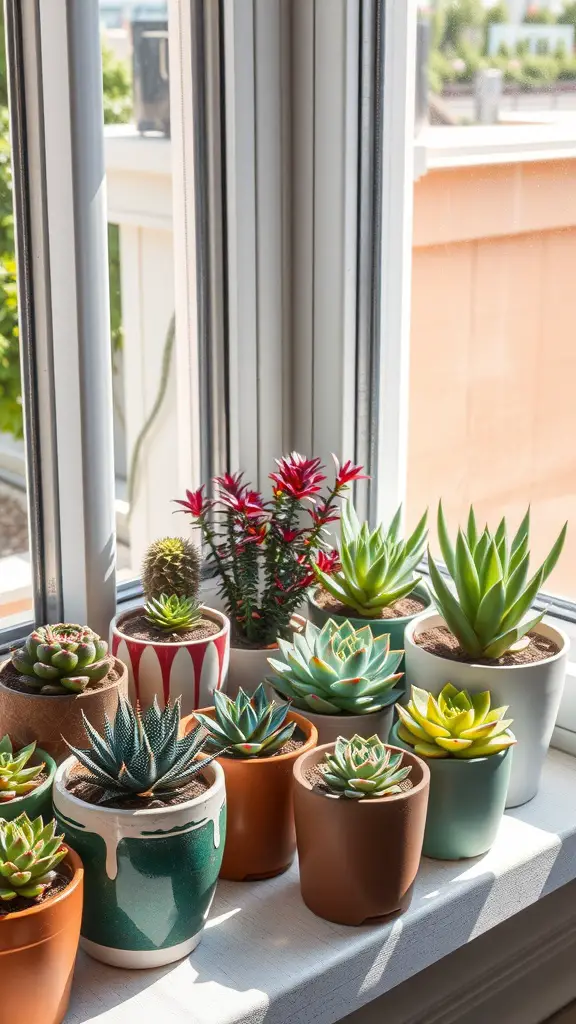
Succulents are fantastic for indoor gardening. They require little care and boast diverse forms and hues, mirroring the image. Notice the assorted pots brimming with vibrant green plants, each enhancing the sunny windowsill with unique appeal.
Light is key when nurturing succulents. They flourish in bright conditions. A sunny windowsill, as pictured, is perfect. Aim for at least six hours of daily sunlight to ensure robust health and vibrant color.
Proper watering is key for succulents. Unlike many houseplants, they thrive when the soil dries completely between waterings. Check the soil moisture by inserting your finger about an inch deep. Water only if the soil feels dry. Overwatering is a common mistake that can cause root rot, so be cautious.
Opt for a succulent-specific, well-draining soil mix. This prevents waterlogged roots. The pictured pots are stylish, but drainage holes are crucial for excess water runoff.
Finally, watch for pests. Succulents are resilient, but mealybugs and aphids can still appear. Check your plants often. If you spot any pests, treat them right away.
Creating a Plant Care Schedule

Successful indoor gardening requires a well-defined strategy. The picture showcases a useful plant care calendar. This tool promotes organization and prevents you from overlooking crucial maintenance.
The image displays a calendar designed for plant care. It highlights daily tasks like watering and fertilizing. A red circle marks a day needing special attention, perhaps for pest control or deep watering.
Next to the calendar, essential tools await: pruning shears and trowels. Keep these tools nearby for effortless plant care. Quickly access what you need to maintain thriving, healthy plants.
Finally, remember that young plants need regular care to flourish. A consistent schedule will help them thrive, bringing life to your home. Get your calendar ready and plan your plant care now!
Choosing the Right Containers for Indoor Plants
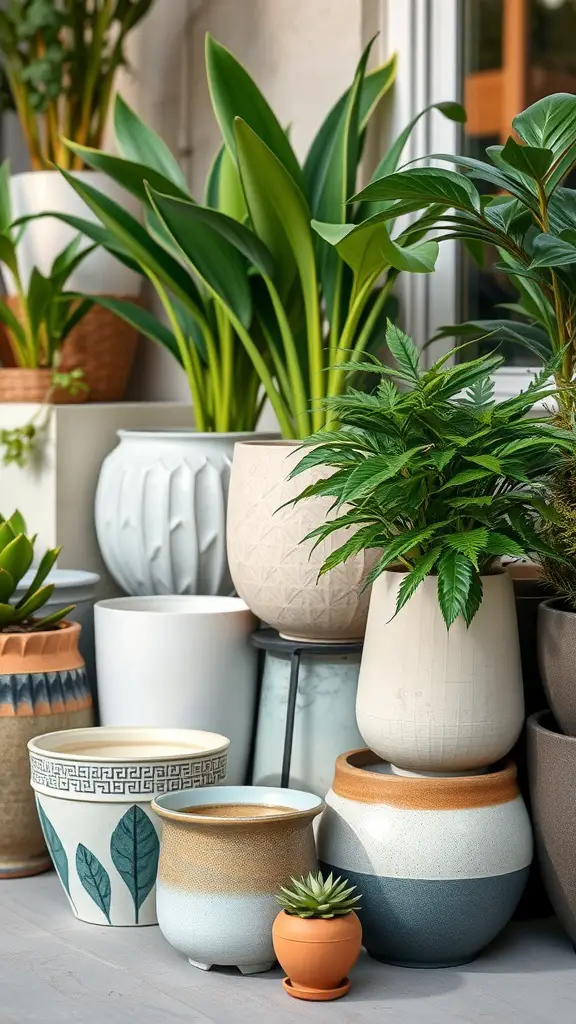
Choosing the perfect container is crucial for indoor plant success. The image displays a selection of stylish pots, enhancing your home’s aesthetic and nurturing your plants. Materials range from ceramic to terracotta, each offering distinct advantages.
Select pots that match your plants’ size and requirements. Bigger plants usually need wider pots for healthy root development. Smaller plants flourish in charming, smaller pots. The image showcases a variety of shapes and designs. These can add a unique, personal element to your indoor garden in 2025.
Effective drainage is crucial for plant health! Choose pots featuring bottom drainage holes. These holes prevent overwatering and the development of root rot. The image showcases various pot styles, including those with drainage and decorative outer pots designed to hold inner planters.
Elevate your space with aesthetics! The perfect container boosts your room’s style. Consider mixing container styles, as shown. This creates a visually stunning display, highlighting your plants’ beauty.
Creating a Zen Space with Indoor Plants

Bring the tranquility of nature indoors with houseplants. Imagine a serene corner brimming with diverse plants, each enhancing your home’s ambiance. The scene captures a beautiful display of greenery, bathed in sunlight streaming through the window, creating soft shadows on the floor.
These plants not only add vibrancy to your space, but they also purify the air, crucial for a tranquil setting. Observe towering, verdant plants stretching for sunlight, complemented by petite species that introduce varied textures and visual interest.
Selecting the perfect plant pots elevates your home’s aesthetic. Here, white pots paired with woven baskets achieve a balanced, stylish look. They enhance the lush greenery while maintaining a calm and peaceful atmosphere.
Transform your space into a tranquil haven by incorporating indoor plants. Peace lilies, snake plants, and pothos are excellent choices. They’re low-maintenance and adapt well to different lighting, making them perfect for creating a zen atmosphere.
Use varying plant heights and species to boost visual appeal. Feel free to experiment with combinations! A comfortable rug and ample sunlight will finalize your peaceful setting.
Indoor Gardening: A Family Activity
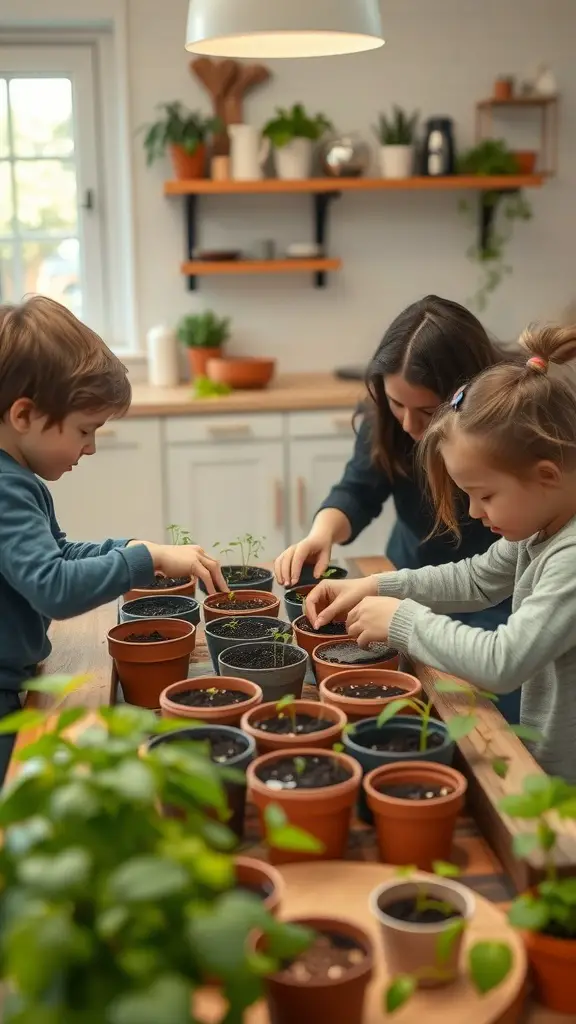
Indoor gardening is more than a pastime. It’s a delightful family experience that unites everyone. The image showcases a heartwarming scene. A mother lovingly guides her children in potting small plants. This moment beautifully illustrates the joy and collaborative spirit fostered by indoor gardening in 2025.
Indoor gardening teaches children responsibility through plant care. Witnessing seed germination into sprouts offers a captivating learning experience. Parents can also use this opportunity to instill the importance of nurturing living organisms in their kids.
This kitchen scene creates a warm, welcoming atmosphere, enhancing the planting experience. The artfully displayed pots on the table encourage everyone to participate. It’s an opportunity to connect, exchange stories, and relish each other’s presence while gardening together!
Managing Indoor Plant Growth and Trimming

Maintaining vibrant indoor plants requires consistent care, and pruning is essential. The image depicts a person meticulously trimming a plant, a fantastic method to stimulate fresh growth. Beyond aesthetics, pruning aids the plant in conserving energy by prioritizing robust branches.
Spotting a plant overgrown or with dead foliage? Grab your pruning shears! Use clean, sharp tools to avoid harm and infection. Trimming shapes the plant and boosts healthy growth. This allows sunlight to reach every part.
Here, someone tends to a plant boasting lush, green foliage. This indicates robust health. Routine pruning can further prevent pests and diseases. Like people, plants benefit from regular care!
Prune your plants at the optimal time. Spring or early summer is ideal for most indoor plants. This is when they’re actively growing, ensuring faster healing and renewed growth.
Common Mistakes to Avoid in Indoor Gardening
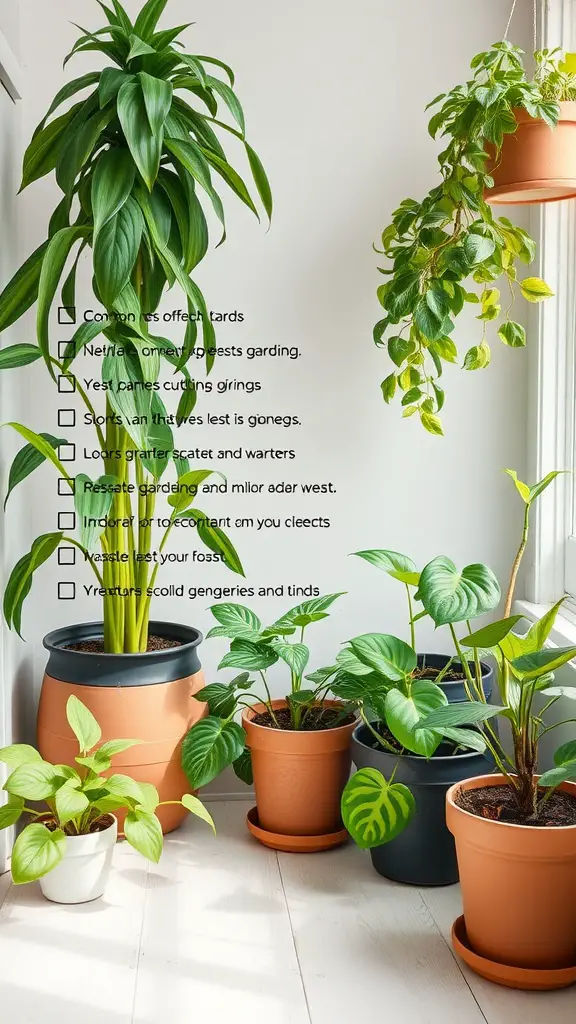
Indoor gardening is a delightful and fulfilling pastime. However, missteps can easily occur. The image showcases a beautiful array of indoor plants in diverse pots, injecting life into the room. To ensure these plants flourish, remember these crucial tips.
A frequent error is excessive watering. Novice gardeners often believe that increased water leads to thriving plants. However, overwatering can cause root rot. Always verify that the topsoil is dry before re-watering.
Insufficient light is a common problem. Plants require proper light levels for healthy development. If your plants are leaning towards the window, they likely need more sunlight. Rotate them frequently to promote balanced growth.
Selecting the correct pots is crucial. Pots that are too small hinder root development. Conversely, oversized pots can cause waterlogged soil. Ensure you choose the appropriate size pot for each plant’s needs.
Finally, be vigilant about pests. They can often infiltrate your garden undetected. Consistent plant inspections are key to early problem detection. This allows for timely treatment, preventing widespread infestation.
Using Indoor Plants for Home Decor

Bring the outdoors in! Indoor plants beautifully elevate your home’s style. They inject vibrancy and a natural touch into any space. This image showcases a welcoming living room, brimming with plants that foster a comfortable and lively ambiance.
A sizable potted plant graces the area next to a cozy couch. Smaller plants adorn the coffee table. This setup enhances the room’s beauty and introduces nature inside. The blend of green plants and neutral furniture tones creates a balanced and peaceful atmosphere.
Introducing plants boosts indoor air quality and fosters a serene atmosphere. Natural sunlight amplifies their beauty, highlighting their vivid hues. You don’t need a jungle; a few well-chosen plants can revitalize your living space.
Experiment with diverse plant species to create captivating textures and heights. Select planters that harmonize with your existing furniture. Remember, nurturing indoor plants is more than decoration; it’s an engaging and rewarding pastime!
Incorporating Indoor Plants in Small Spaces

Indoor greenery revitalizes compact living areas. This image highlights a snug corner brimming with diverse plants. It demonstrates how even small spaces can become verdant and welcoming. Several towering plants thrive by the window, absorbing sunlight. Smaller potted plants are carefully displayed on stands.
Selecting plants for compact areas requires careful attention to their light requirements and growth habits. The featured plants, such as the Monstera and Peace Lily, flourish indoors and tolerate low-light conditions effectively. This allows you to introduce greenery into your space without needing intense direct sunlight, as of 2025.
Combining various pot sizes and designs enhances visual appeal. Observe the blend of terracotta, ceramic, and metal containers in the picture. This diversity fosters a relaxed ambiance, lending a cozy feel to the area. Personalize your plant arrangements effortlessly by choosing pots that complement your interior design.
Maximize your space by thinking vertically! Wall planters and hanging pots are fantastic for displaying plants without taking up floor area. Notice the plants near the window in the picture. They get plenty of sunlight and beautifully utilize the wall space.
Exploring Vertical Gardening Indoors
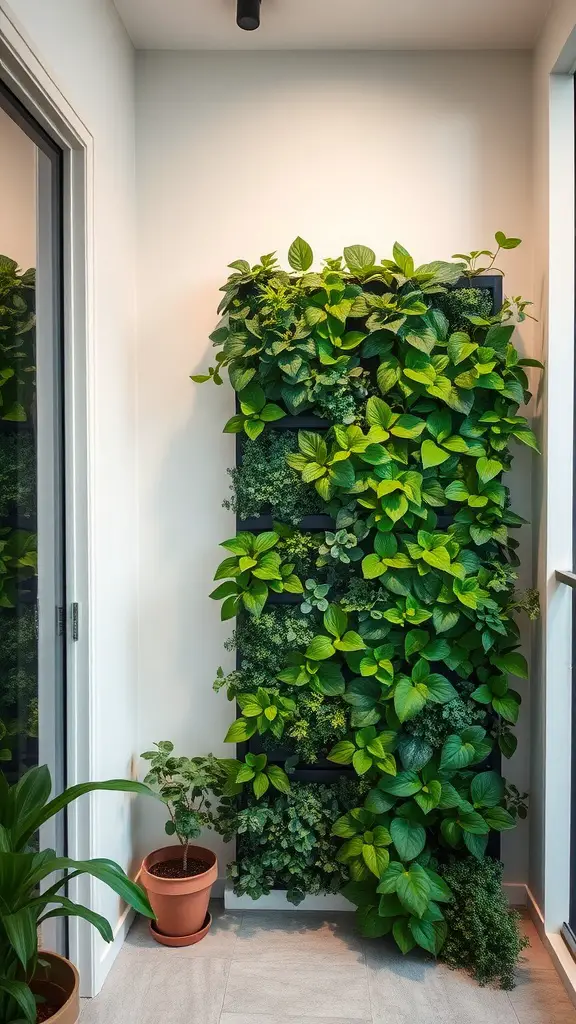
Indoor vertical gardens offer a fantastic solution for plant lovers with limited space. This image showcases a chic vertical garden wall, bursting with vibrant greenery and diverse plant life.
Brighten your home and purify the air with this vibrant setup! These plants are perfect for indoor environments. They flourish with bright, indirect sunlight.
This design maximizes your vertical space. Layering plants adds visual appeal and introduces nature indoors.
Thinking about an indoor garden? Consider growing herbs or compact veggies. Imagine having fresh ingredients readily available in your home! Key care steps involve good drainage and consistent watering. These practices ensure your plants thrive.
Vertical gardens offer a fantastic family activity. Children enjoy watering and watching plants thrive. This gardening method is practical and delightful. It enlivens your indoor environment.
Plants that Purify Indoor Air
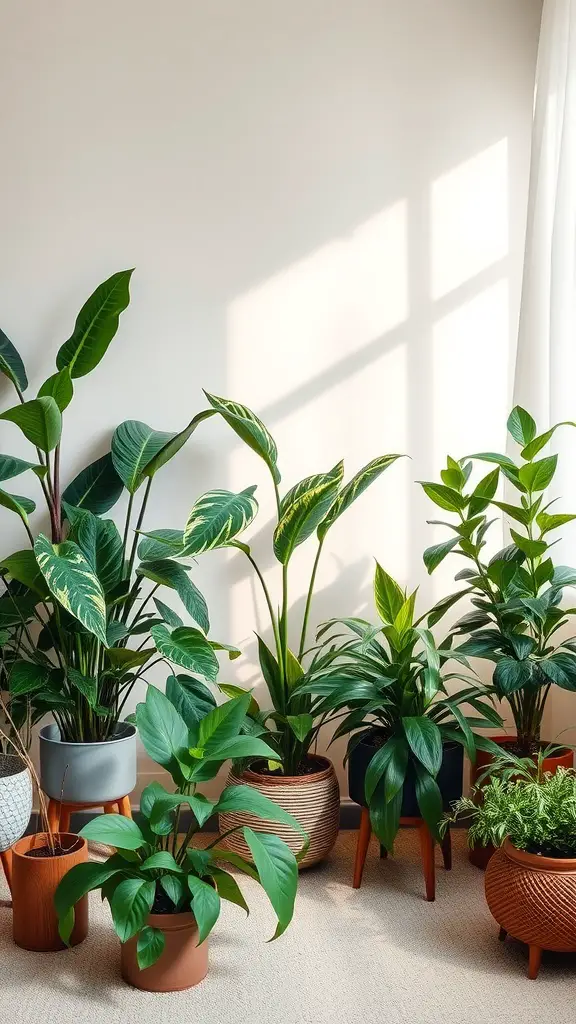
Indoor plants offer more than just aesthetic appeal. They significantly enhance indoor air quality. This image features a beautiful collection of plants. These plants are well-known for their natural air-purifying capabilities.
Observe the lively foliage of these plants, each enhancing your home’s well-being. The Peace Lily and Snake Plant are famous for removing prevalent toxins such as formaldehyde and benzene.
These plants actively combat indoor pollutants, creating a fresher and healthier home environment. They also introduce natural beauty and a sense of tranquility to any space. Envision breathing purified air while surrounded by the soothing influence of living greenery!
Indoor plants flourish with consistent care. Water them regularly and ensure they get enough light. Start your indoor garden today! It’s an easy way to improve your home and boost your mood.